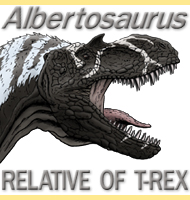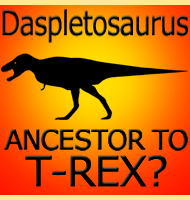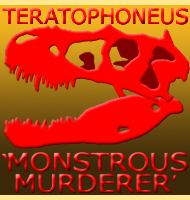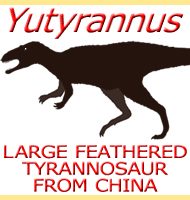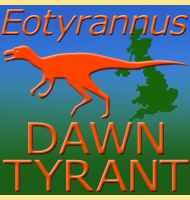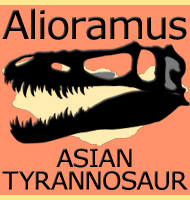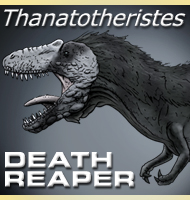


Raptorex
Name: Raptorex
(Thief king).
Phonetic: Rap-tor-reks.
Named By: P. Sereno, L. Tan, S. L.
Brusatte, H. J. Kriegstein, M. Zhao & K.
Cloward - 2009.
Classification: Chordata, Reptilia, Dinosauria,
Saurischia, Theropoda, Tyrannosauroidea, Tyrannosauridae,
Tyrannosaurinae.
Species: R. kriegsteini
(type).
Diet: Carnivore.
Size: About 2.5 meters long for holotype.
Known locations: Uncertain, but possibly Mongolia.
Time period: Uncertain, but probably Campanian.
Fossil representation: Single juvenile.
Raptorex
is a very dubious genus of tyrannosaur
that many consider to be a
juvenile Tarbosaurus.
When Raptorex was first revealed to the world
the holotype had already been dug out of the ground and shipped to
Japan where it was purchased by an American businessman. Back then
the fossil was being identified as a juvenile Tarbosaurus
and coming
from the Yixian Formation of China. Alarm bells should already be
ringing at this for two reasons. First, there is a law in China
that makes it illegal to export genuine fossils from beyond China’s
borders, and any legitimate original fossils would have to be on the
black market, a far from reliable scientific source as black market
fossils dealers will say anything about fossils just to sell them.
Proof
of this deception comes from the second point to be made. The
original dealer said that this specimen was a juvenile Tarbosaurus
from
the Yixian Formation. However, Tarbosaurus is
known to have lived
during the Campanian and Maastrichtian periods of the Late Cretaceous
period roughly around 70-66 million years ago. The Yixian
Formation however is dated to the Barremian/Aptian of the Early
Cretaceous around 125-121 million years ago. This leaves two
possibilities, one is that Tarbosaurus has the
longest temporal span
in the fossil record of any tyrannosaur, and also indicates that
advanced form tyrannosaurs were living at a time when previously only
primitive forms were known, or, alternatively, the fossil dealer
lied about the specimen coming from the Yixian Formation.
When
the specimen was shipped to the United States it was sold on again at
the Arizona Gem, Mineral and Fossil Show in Tucson. The buyer was a
Dr. Henry Kreigstein, himself a fossil collector. Kreigstein
contacted one of the more noted American palaeontologists, Paul
Sereno, to examine the specimen, stating that it was bought as a
juvenile Tarbosaurus from the Yixian Formation.
The first thoughts of
Sereno and his team about the specimen were that coming from the Yixian
Formation the specimen was not a juvenile Tarbosaurus,
but a whole
new genus of previously unknown tyrannosaur. Naming the specimen
Raptorex in 2009, they concluded that the
specimen was six years
old at the time of death and almost fully grown, and concluded that
the body form of later tyrannosaurs had already become established
before they grew to the large sizes that they are known for from the
late Cretaceous.
Sereno’s
team also tried to locate the area and time that that the fossil
deposit was laid down. To do this they looked at the occurrences of
other smaller fossils of creatures that were embedded around the
Raptorex holotype. They identified vertebrae
belonging to fish as
coming from the genus Lycoptera,
a genus known to have lived in China
up until the same time in the early Cretaceous as well as be present in
the Yixian Formation. For Sereno and his team this was proof enough
that the specimen did indeed come from the Yixian Formation, and that
Raptorex was a ground breaking discovery in our
understanding of
tyrannosaur evolution.
The
first publicised doubts about Raptorex came in
2010 when after
examining the holotype fossil, Peter Larson of the Black Hills
Institute of Geological Research, Inc. (a private fossil excavation
company), could only identify the fossil remains as a juvenile
Tarbosaurus. Larson also suggested that a much
more detailed
examination of the matrix, the rock that the Raptorex
fossils were
attached too should be undertaken, ideally with an objective to try
and locate pollen to identify known plant types of the Cretaceous
eras. This criticism appeared in the publication Nature, but in a
response at the time, Sereno stated that no peer reviewed paper had
produced evidence to refute his analysis.
However,
in 2011, and less than one year after Larson, had first made
doubts, a scientific paper refuting the interpretation was
published, focusing upon the Raptorex fossils and
the matrix. In
2009 Sereno had stated that the vertebrae of Raptorex
were nearly
fused, denoting a subadult and almost fully grown specimen. However
in the 2011 paper Sereno’s team were criticised for misinterpreting
growth pattern data, and that not only were the vertebrae of Raptorex
unfused, but the age of the animal would have only been three years
old. They also examined the fish vertebrae that Sereno’s team
assigned to the Lycoptera genus, and stated that
not only were they
not of Lycoptera, they were not even of the same
type of fish as
Lycoptera.
In
2013 things were narrowed down even further with a paper by Newbrey
et al, which confidently identified the fish vertebrae as belonging
to a hiodontid fish. In addition to this, the species of
hiodontid fish that the vertebrae on the matrix match up to are only
known from the Nemegt Formation which is in Mongolia. This is a key
development as not only is the Nemegt Formation Late Cretaceous in
age, Tarbosaurus fossils are also known from
here, in fact they
are surprisingly common with large numbers already being recovered.
It is for these reasons that Raptorex is largely
regarded as a
dubious genus, and probable juvenile of Tarbosaurus
by most.
Further reading
- Tyrannosaurid skeletal design first evolved at small body size.
-
Science 326 (5951): 418–422. - P. Sereno, L. Tan,
S. L. Brusatte, H. J. Kriegstein, M. Zhao &
K. Cloward - 2009.
- Reanalysis of Raptorex kriegsteini: A Juvenile Tyrannosaurid
Dinosaur from Mongolia. - PLoS ONE 6(6): e21376. - D.
W. Fowler, H. N. Woodward, E. A. Freedman, P. L.
Larson & J. R. Horner - 2011.
- Teleost centrum and jaw elements from the Upper Cretaceous Nemegt
Formation (Campanian-Maastrichtian) of Mongolia and a
re-identification of the fish centrum found with the theropod Raptorex
kreigsteini. - Michael G. Newbrey, Donald B.
Brinkman, Dale
A. Winkler, Elizabeth A. Freedman, Andrew G. Neuman, Denver
W. Fowler & Holly N. Woodward - In, Mesozoic
Fishes 5 –
Global Diversity and Evolution. Verlag Dr. Friedrich Pfeil. pp.
291–303 - Gloria Arratia, Hans-Peter Schultze & Mark
V. H. Wilson (eds) - 2013.
----------------------------------------------------------------------------
Random favourites
 |
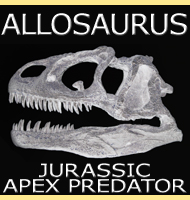 |
 |

